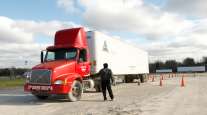Senior Reporter
DTNA Concerned About Added Costs from Federal Greenhouse-Gas Rule

ORLANDO, Fla. — A senior compliance engineer for Daimler Trucks North America told a group of maintenance technicians and executives that the truck maker has concerns about the federal government’s possible added costs and testing plans that could be included in the Phase 2 greenhouse gas emissions and fuel efficiency proposed rule due for publication next spring.
Amy Kopin said that with the exception of both engine and vehicle standards, the Phase 1 joint rule went relatively well for truck manufacturers.
“But we are concerned that Phase 2 will not work the same way,” Kopin said here at a Sept. 23 panel discussion at the 2014 fall meeting of the American Trucking Associations’ Technology & Maintenance Council.
Kopin said that the Phase 2 rule should adopt a complete vehicle standard with no separate engine standard.
In Phase 1, despite many concerns raised by the OEMs and other stakeholders, the U.S. Environmental Protection Agency and National Highway Traffic Safety Administration created two parallel programs for medium- and heavy-duty engines and vehicles, she said.
But another panel member, Dennis Johnson, director of the EPA’s Technology Assessment Center, stressed that medium- and heavy-duty trucks are increasingly contributing to climate change.
Medium and heavy trucks accounted for 20% of the U.S. transportation sector’s greenhouse-gas emissions in 2012, but in “20 or 30” years will jump to 40%, he said.
As a result, Johnson’s agency is seriously considering a requirement in the Phase 2 rule that manufacturers deploy aerodynamic technologies on heavy truck trailers, an EPA official said.
The Phase 1 rule, which went into effect this year, is projected to save 530 million barrels of oil, 270 million metric tons of greenhouse gases and $50 billion in fuel costs, Johnson said.
The plan for the second phase — announced Feb. 14 by President Obama — will follow up the 2014 regulation to demand even tougher carbon dioxide emissions and fuel-consumption improvements in heavy- and medium-duty trucks.
The proposed EPA-NHTSA Phase 2 rule is expected in March, and the final rule in 2016, but it is not expected to take effect until 2021.
In addition to trailers, new engine technologies, testing procedures, power-train opportunities and low-rolling-resistance tires are being considered for the Phase 2 rule, Johnson said.
An April report by the National Academy of Sciences “strongly recommended” that EPA should begin regulating trailers in Phase 2, he said.
Johnson said EPA is looking at all types of trailer technologies, including the California Air Resources Board’s truck and bus regulation that is gradually requiring fleets and independent operators to deploy aerodynamic technologies and low-rolling-resistance tires on trailers.
However, unlike the CARB regulation, the responsibility would be placed on trailer manufacturers rather than truckers, he said.




